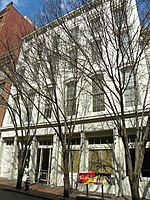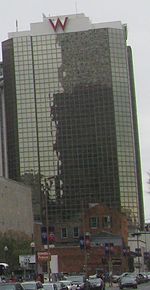Trump International Hotel and Tower (New Orleans)
The Trump International Hotel and Tower was a proposed residential tower located in the Central Business District of New Orleans, Louisiana. It was a project of real estate mogul Donald Trump's Trump Organization. Supposedly in the planning stages from summer 2005 on, the project was finally declared dead in July 2011 after the location land was foreclosed on and sold at auction. If constructed, the Trump Tower would have become the tallest building in the city of New Orleans and the state of Louisiana, at seventy stories. At a height of 716 feet (218 m) along with a 126-foot (38 m) spire, it would also be the tallest building along the Gulf Coast outside of Houston, as well as the tallest point in the state of Louisiana. (Louisiana's highest peak is Driskill Mountain, at 535 feet.) It was planned to be a multi-use building with the ground floors allocated for retail shopping, the lower floors would have been luxury condo-hotels and the upper floors will be luxury condominiums.
Excerpt from the Wikipedia article Trump International Hotel and Tower (New Orleans) (License: CC BY-SA 3.0, Authors).Trump International Hotel and Tower (New Orleans)
Camp Street, New Orleans Storyville
Geographical coordinates (GPS) Address Website Nearby Places Show on map
Geographical coordinates (GPS)
| Latitude | Longitude |
|---|---|
| N 29.9493 ° | E -90.0684 ° |
Address
Premium Parking Lot P296
Camp Street 408
70130 New Orleans, Storyville
Louisiana, United States
Open on Google Maps









